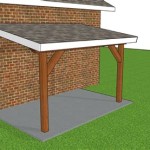How To Clean Stone Patio Pavers
Maintaining a clean and aesthetically pleasing stone patio requires understanding appropriate cleaning methods and preventative measures. Stone pavers, while durable, are susceptible to staining, discoloration, and the accumulation of organic matter. Regular cleaning extends the life of the patio and ensures a safe and enjoyable outdoor space.
Before commencing any cleaning process, it is crucial to identify the type of stone patio paver. Common materials include bluestone, flagstone, travertine, limestone, and concrete pavers designed to mimic natural stone. Each material possesses unique properties, impacting its porosity, susceptibility to staining, and reaction to cleaning agents. Misidentification can lead to irreversible damage and discoloration.
The frequency of cleaning depends on several factors, including the patio's exposure to the elements, foot traffic, and proximity to vegetation. Patios located under trees or in areas with high rainfall may require more frequent cleaning than those in drier, sunnier locations. Generally, a thorough cleaning once or twice a year is recommended, supplemented by routine sweeping and spot cleaning as needed.
Preparing for the Cleaning Process
Proper preparation is essential for an effective and safe cleaning process. This involves gathering the necessary tools and materials, protecting surrounding vegetation, and taking precautions to prevent damage to the pavers themselves.
First, assemble the required tools. A stiff-bristled brush, a garden hose with a spray nozzle, a bucket, and appropriate cleaning solutions are fundamental. For stubborn stains or large areas, a pressure washer may be considered, but caution must be exercised to avoid damaging the stone. Soft-bristled brushes are often preferable for more delicate stone types to prevent scratching or abrasion.
Next, thoroughly sweep the patio to remove loose debris such as leaves, dirt, and twigs. This step prevents the debris from being ground into the pavers during the cleaning process, minimizing the risk of scratching and making the cleaning solution more effective. Pay particular attention to the joints between the pavers, as this is where debris tends to accumulate.
Protect any surrounding vegetation by covering plants with plastic sheeting or tarps. Cleaning solutions, even those marketed as environmentally friendly, can harm or kill plants if they come into direct contact. Consider wetting surrounding plants with water before beginning the cleaning process to help dilute any accidental spills.
Before applying any cleaning solution to the entire patio, test it on an inconspicuous area to ensure it does not cause discoloration or damage. Allow the solution to sit for the recommended amount of time, then rinse thoroughly and observe the area for any adverse reactions. If discoloration occurs, select a different cleaning solution or adjust the concentration.
Safety precautions are paramount during the cleaning process. Wear appropriate protective gear, including gloves and eye protection, to prevent skin and eye irritation. Ensure adequate ventilation, especially when using chemical cleaning solutions, and follow the manufacturer's instructions carefully. Keep children and pets away from the area during and after the cleaning process until the pavers are completely dry.
Selecting the Right Cleaning Solution
The choice of cleaning solution is crucial for achieving optimal results without damaging the stone pavers. Several options are available, ranging from mild household detergents to specialized stone cleaners. Understanding the properties of each type of solution and its suitability for different types of stone is essential.
For general cleaning and routine maintenance, a mild solution of dish soap and warm water is often sufficient. This solution is effective at removing dirt, grime, and light stains. Apply the solution to the pavers, scrub gently with a brush, and rinse thoroughly with water. Avoid using abrasive cleaners or scouring pads, as these can scratch or dull the surface of the stone.
For more stubborn stains, such as algae, moss, or mildew, a solution of water and white vinegar can be used. Mix equal parts water and white vinegar in a spray bottle and apply to the affected areas. Allow the solution to sit for 15-20 minutes, then scrub with a brush and rinse thoroughly. Vinegar is a mild acid and can be effective at breaking down organic matter, but it should be used with caution on acid-sensitive stones such as limestone and marble.
Commercial stone cleaners are formulated specifically for cleaning stone pavers and are often the best choice for removing tough stains and restoring the stone's natural appearance. These cleaners are available in a variety of formulations, so it is important to select one that is compatible with the type of stone being cleaned. Follow the manufacturer's instructions carefully, and always test the cleaner on an inconspicuous area before applying it to the entire patio.
Avoid using harsh chemicals such as bleach, ammonia, or muriatic acid on stone pavers. These chemicals can damage the stone, causing discoloration, etching, and even structural damage. In addition, these chemicals can be harmful to the environment and pose a health risk to humans and animals.
Environmentally friendly cleaning options are available for those who prefer to avoid harsh chemicals. These options often utilize natural ingredients such as enzymes, citrus extracts, or hydrogen peroxide to clean and disinfect the pavers. While these solutions may not be as powerful as some chemical cleaners, they are generally safer for the environment and can be effective at removing many types of stains.
Cleaning Techniques and Best Practices
The method of cleaning stone patio pavers impacts the final outcome. Some techniques, like pressure washing, need careful calibration to prevent damage, while others require more manual effort.
Pressure washing can be an effective method for cleaning large areas of stone pavers quickly, but it must be used with caution. High-pressure water can damage delicate stones or etch the surface of harder stones. If using a pressure washer, use a wide fan nozzle and keep the nozzle at least 12 inches away from the surface of the pavers. Start with a low-pressure setting and gradually increase the pressure until the dirt and grime begin to loosen. Avoid using a concentrated stream of water, as this can damage the stone and grout.
For manual cleaning, apply the chosen cleaning solution to the pavers and allow it to sit for the recommended amount of time. Scrub the pavers with a stiff-bristled brush, paying particular attention to stained or heavily soiled areas. Rinse the pavers thoroughly with water to remove all traces of the cleaning solution. Use a garden hose with a spray nozzle to ensure all residue is removed.
When cleaning the joints between the pavers, use a narrow brush or grout brush to remove dirt and debris. For stubborn weeds, consider using a weeding tool or a specialized weed killer designed for use on patios. Be careful to avoid damaging the pavers when removing weeds.
For oil stains, apply a poultice made from baking soda and water or a commercial oil stain remover. Apply the poultice to the stain, cover it with plastic wrap, and allow it to sit for 24-48 hours. Remove the poultice and rinse the area thoroughly with water. Repeat the process if necessary.
For rust stains, use a commercial rust remover specifically designed for use on stone. Follow the manufacturer's instructions carefully, and test the remover on an inconspicuous area before applying it to the entire stain. Avoid using household rust removers, as these may contain harsh chemicals that can damage the stone.
After cleaning, allow the pavers to dry completely before sealing them. Sealing the pavers helps to protect them from staining and water damage, and it can also enhance their natural appearance. Choose a sealant that is specifically designed for use on stone pavers and follow the manufacturer's instructions carefully.
Prevention is key to keeping stone patio pavers clean. Regularly sweep the patio to remove loose debris, and promptly clean up any spills or stains. Consider placing mats or rugs at entry points to prevent dirt and grime from being tracked onto the patio. Trim back vegetation that overhangs the patio to reduce the amount of organic matter that accumulates on the pavers.
By following these cleaning techniques and best practices, stone patio pavers can be maintained, ensuring a visually appealing and durable outdoor living space for years to come. Regular maintenance is crucial to avoiding costly repairs or replacements in the future.

How To Clean Patio Pavers At Home Advantage Pro Services

How To Clean Pavers A Guide Cleaning Patio

How To Remove Efflorescence From Your Paving Stones Western Interlock

How To Clean Decorative Stone Pavers Boulders Gravel Meyer Landscape

How To Clean Pavers A Guide Cleaning Patio

Remove Algae And Lichen Off Patio Pavers Like Rick Wet Forget Blog

How To Clean Patio Slabs Minster Paving

Cleaning Patio Pavers Tips And Techniques Sequoia Stonescapes

How To Clean Renovate Yorkstone Flags Pavers York Stone Care

How To Clean N Sandstone Paving Beautifully 7 Steps








